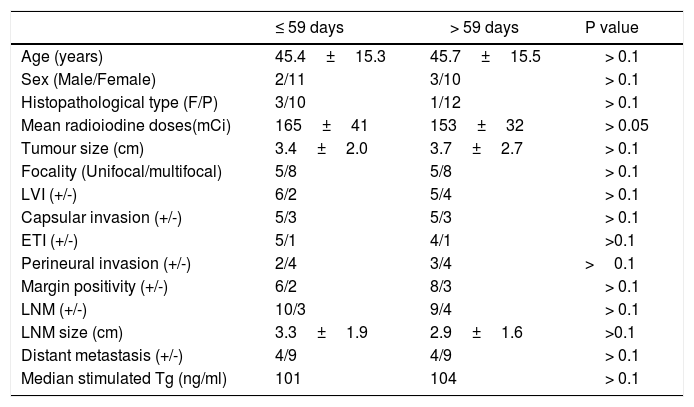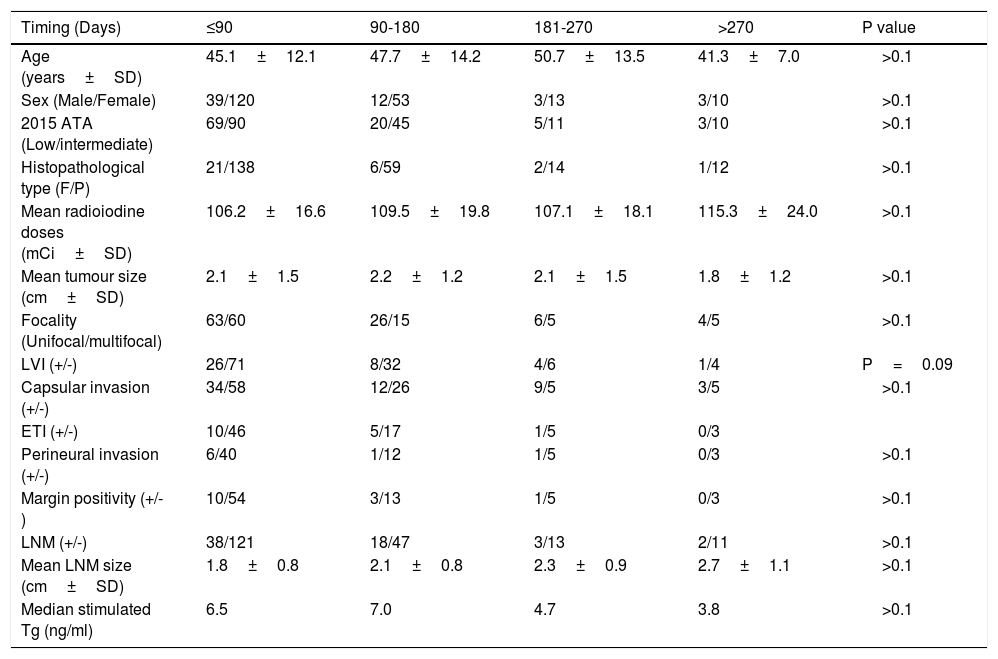It's difficult to make a scientific, evidence-based approach about the timing of radioiodine remnant ablation (RRA) in patients with differentiated thyroid carcinomas (DTCs). Primary aim of the study was to reveal whether timing of RRA relates to achievement of non- structurally incomplete response (non-SIR) in low/intermediate and high-risk patients. Another aim was to reveal the correlation of timing with non-SIR status in reproductive-age women.
Materials and MethodsRecords of 279 low, intermediate, and high-risk patients were analysed, retrospectively. Number of days between surgery and RRA is referred to as timing. Low/intermediate-risk patients, high-risk patients, and low/intermediate-risk reproductive-age women were divided into non-SIR and SIR groups, according to 2015 American Thyroid Association guidelines for therapy response. The relationship between timing and therapy response was analysed statistically.
ResultsWe could not find any significant relationship in patients with low/intermediate risk between timing and non-SIR, including women between 18-49 years of age (p >0.1). For high-risk patients, we found a statistically significant relationship between timing and non-SIR response. According to ROC analysis, RRA ≤58 days was found as a cut-off value. The sensitivity, specificity, positive likelihood ratio, and negative likelihood ratio were calculated as 83.3%, 70.0%, 2.78, and 0.24, respectively.
ConclusionRRA must be initiated within 58 days after surgery in patients with high-risk DTCs. Under this approach, risk of SIR and associated mortality risk may be reduced. RRA timing for women in reproductive ages with low/intermediate risk groups may be planned according to their pregnancy/breastfeeding intent. For other low/intermediate risk groups, they can safely proceed according to the capacity of the medical facility and related logistical considerations.
Es difícil adoptar un enfoque científico basado en la evidencia con respecto al intervalo de aplicación de la ablación de restos con yodo radiactivo (RRA) en pacientes con carcinoma diferenciado de tiroides (DTC). El objetivo principal del estudio fue revelar si el intérvalo de aplicación de la RRA está relacionado con la obtención de una respuesta no estructuralmente incompleta (no SIR) en pacientes de bajo/intermedio y alto riesgo. Otro objetivo era revelar la correlación entre el plazo de aplicación y el estado no SIR en las mujeres en edad reproductiva.
Materiales y métodosSe analizaron retrospectivamente los registros de 279 pacientes de bajo, intermedio y alto riesgo. El «intérvalo de aplicación» se refiere al número de días entre la cirugía y la RRA. Las pacientes de bajo/intermedio riesgo, las pacientes de alto riesgo y las mujeres en edad reproductiva de bajo/intermedio riesgo se dividieron en grupos SIR y no SIR, de acuerdo con las directrices de 2015 de la Asociación Estadounidense de la Tiroides para la respuesta terapéutica. Se analizó estadísticamente la relación entre el intérvalo de aplicación y la respuesta terapéutica.
ResultsNo se observó ninguna relación significativa en pacientes con riesgo bajo/intermedio entre el intérvalo de aplicación y la respuesta no SIR, incluidas las mujeres de 18 a 49 años de edad (p > 0,1). Para los pacientes de alto riesgo, se encontró una relación estadísticamente significativa entre el intérvalo de aplicación y la respuesta no SIR. Según el análisis de ROC, se encontró que el valor límite era RRA ≤ 58 días. Se calcularon la sensibilidad, especificidad, cociente de probabilidad positivo y cociente de probabilidad negativo en 83,3%, 70,0%, 2,78 y 0,24, respectivamente.
ConclusiónLa RRA debe comenzar dentro de los 58 días después de la cirugía en pacientes con DTC de alto riesgo. De este modo, se puede reducir el riesgo de SIR y el riesgo de mortalidad asociado. Para las mujeres en edad reproductiva con grupos de riesgo bajo/intermedio, se puede planificar el plazo de aplicación de la RRA de acuerdo con los planes que tengan en cuanto al embarazo o la lactancia. Para otros grupos de riesgo bajo/intermedio, pueden proceder con seguridad de acuerdo con la capacidad de la instalación médica y las consideraciones logísticas relacionadas.
Article
If you experience access problems, you can contact the SEMNIM Technical Secretariat by email at secretaria.tecnica@semnim.es or by phone at +34 619 594 780.

Revista Española de Medicina Nuclear e Imagen Molecular (English Edition)











